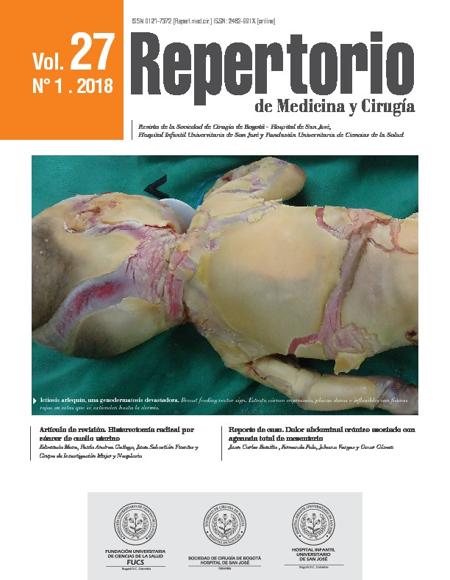Necroética: el cuerpo muerto y su dignidad póstuma
Necroética: the dead body and his posthumous dignity
Cómo citar
Descargar cita
Esta obra está bajo una licencia internacional Creative Commons Atribución-NoComercial-CompartirIgual 4.0.
Mostrar biografía de los autores
Visitas del artículo 3768 | Visitas PDF 1900
Descargas
1. Gareth D y Whitaker MI. Speaking for the Dead. The Human Body in Biology and Medicine. Farnham: Ashgate Publishing Limited, 2009.
2. Redacción El Tiempo. Cierran Morgue de la Universidad Libre [en línea] 1992. Disponible en [http://www.eltiempo.com/archivo/documento/MAM-53904] (consultado en 14 de octubre de 2017).
3. Shell SM. Kant and the «paradox» of autonomy En Sensen O. Kant on Moral Autonomy. New York: Cambridge University Press, 2013.
4. Matheny G. Utilitarianism and Animals. Singer P (ed.). In Defense of Animals. The Second Wave. Malden: Blackwell Publishing Ltd, 2006.
5. Blanco M. Reflexiones morales sobre los animales en la filosofía de Martha Nussbaum. Revista de Bioética y Derecho, 2012, 25, 59-72.
6. Solbakk JH. Ética y responsabilidad: el pensamiento de la Grecia Clásica y sus lecciones sobre bioética contemporánea en (Bio) ética y cine Tragedia griega y acontecimiento del cuerpo, Michel Fariña JJ y Solbakk JH (eds.). Buenos Aires: Letra Viva, 2012.
7. Van Hooft S. Life, Death and Subjectivity. Moral Sources in Bioethics. Amsterdam: Rodopi B.V., 2004.
8. Perosino MC. Un cadáver humano. Cuadernos de ética. 2014; 29 (42): 1-22.
9. Neimeyer R. Aprender de la pérdida. Barcelona: Paidós, 2002.
10. Morar S, Perju-Dumbrav D, Cristian A. Ethical and legal aspects of the use of the dead human body for teaching and scientific purposes. Romanian Journal of Bioethics, 2008, 6 (4): 75-83.
11. Verdery K. The Political Lives of Dead Bodies. New York: Columbia University Press, 1999.
12. Perosino MC. Acerca del riesgo en la muerte ausente. Revista Sans Soleil - Estudios de la Imagen. 2012; 4: 196-206.
13. Skloot R. The Immortal Life of Henrietta Lacks. New York: Crown Publishers, 2010.
14. Cocks M. The hidden curriculum. CMAJ. 2014; 186 (2): 152.
15. McLachlan JC, Patten D. Anatomy teaching: ghosts of the past, present and future. Med Educ. 2006; 40 (3): 243-253.
16. Goodwin D, Machin L y Taylor A. The social life of the dead: The role of post-mortem examinations in medical student socialization. Social Science & Medicine. 2016; 161:100-8.
17. Talarico EF Jr. A change in paradigm: giving back identity to donors in the anatomy laboratory. Clin Anat. 2013; 26 (2):161-72.
18. Feinberg J. The nature and the value of rights En: Coleman J (ed.) Rights and their foundations. New York-London: Garland Publishing, 1974.
19. Rosenblatt A. International forensic investigations and the Human Rigths of the Dead. Human Rights Quarterly. 2010; 32(4): 921–950.
20. Wilkinson TM. Respect for the dead and the ethics of anatomy. Clin Anat. 2014; 27 (3): 286-90.
21. República de Colombia. Ministerio de Salud Pública. Decreto 786 de 1990, articulo 4.
22. Kolata G. In a giant’s story, new chapter writ by his DNA. The New York Times. 2011. Ene. 11.
23. Doyal L y Muinzer T. Should the skeleton of «the Irish giant» be buried at sea? BMJ, 2011; 343:d7597.
24. Oberman M. American Associaton of Law Schools Panel: Panel on the use of patients for teaching purposes without their knowledge or consent. Journal of Health Care Law and Policy. 2005; 8 (2): 210-215.
25. Escalona R. Consentimiento informado en anatomía patológica como requerimiento ético para la calidad y la excelencia. MEDISAN. 2011; 15 (1):138.
26. República de Colombia. Congreso de la República. Ley 73 de 1988.
27. República de Colombia. Congreso de la República. Ley 1805 de 2016.
28. Álvarez-Díaz JA. Bioética y anatomía patológica. Patol Rev Latinoam. 2012; 50 (4): 311-319.
29. Bernal JS. Reproducción asistida y filiación. Tres casos. Opinión Jurídica. 2013; 12 (24), 135-150.
30. Comesaña G. Sobre la exposición Bodies. Enl@ce: Revista Venezolana de información, tecnología y conocimiento. 2009; 6 (1): 115-131.
31. Leiboff M. A Beautiful Corpse. Continuum: Journal of Media & Cultural Studies. 2005; 19 (2): 221–237.
32. Instituto Nacional de Medicina Legal y Ciencias Forenses. ¿Qué es el RND? [en línea] Disponible en [http://www.medicinalegal.gov.co/red-nacional-de-busqueda-de-personas-desaparecidas-y-cadaveres-en-condicion-de-no-identificado] (consultado en 28 de diciembre de 2017).
33. Instituto Nacional de Medicina Legal y Ciencias Forenses. De NN a una condición de no identificado [en línea] Disponible en [http://www.medicinalegal.gov.co/de-nn-a-una-condicion-de-no-identificado] (consultado en 28 de diciembre de 2017).
34. Instituto Nacional de Medicina Legal y Ciencias Forenses. Resolución 382 de 2015.
35. Landranchi G. Chirurgia Magna (1296, printed in 1479). As translated by James Joseph Walsh in Old-Time Makers of Medicine, 1911.













